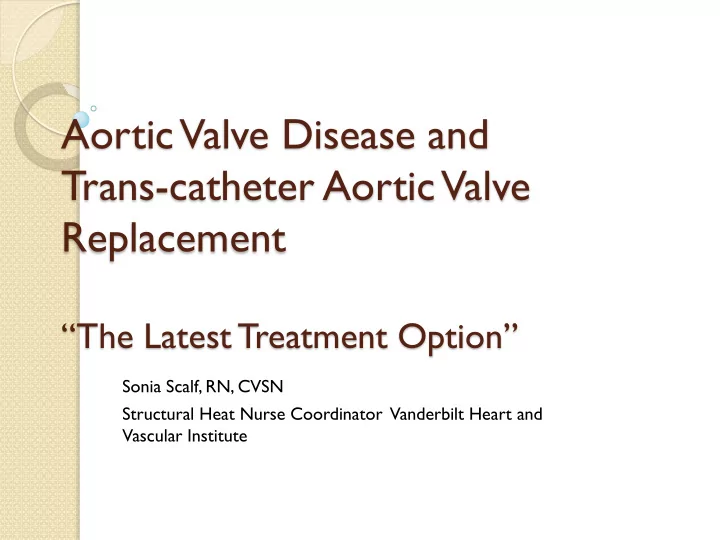

Aortic Valve Disease and Trans-catheter Aortic Valve Replacement “The Latest Treatment Option” Sonia Scalf, RN, CVSN Structural Heat Nurse Coordinator Vanderbilt Heart and Vascular Institute
Aortic Stenosis Aortic stenosis is the most important cardiac valve disease in developed countries, affecting 3 percent of persons older than 65 years. Aortic valve replacement is the only effective treatment for patients with severe symptomatic aortic stenosis.
What is Aortic Stenosis? Aortic stenosis: is a buildup of calcium deposits in the valve, which causes it to narrow and reduce blood flow to the rest of your body.
Types of Aortic Stenosis
Aortic Stenosis is Progressive • Asymptomati • Asymptomati c c Healthy Mild Moderate Severe • Mild • Mild to severe symptoms symptoms • Asymptomati • Asymptomati c c
Symptoms of aortic valve disease are Most Common Symptoms commonly misunderstood by patients as Shortness of breath normal signs of aging. Fatigue Difficulty walking short distances Dizziness or passing out Swollen ankles, feet and legs Chest Pain Lack of motivation to participate Fast heartbeat What are the Symptoms of Aortic Stenosis?
What’s the big deal? 80 year olds are supposed to be tired, right? Blase A Carabello, Walter J Paulus Lancet 2009; 373: 956–66
Said another way… 8 5-Year Survival Survival, % Breast Lung Colorectal Prostate Ovarian Severe Cancer Cancer Cancer Cancer Cancer Inoperable AS*
The Prevalence of Aortic Stenosis Increases with Age Nkomo et al. Lancet 2006; 368: 1005–11
How often should you have an Echocardiography (ECHO) ECHO An echocardiogram (echo) can Mild Every 3 to 5 confirm your symptoms and years tell how severe your stenosis. Moderate Every 1 to 2 years It's also an important test Severe Every 6 to to help monitor aortic 12 valve stenosis over time. How Do You Get Diagnosed?
Other T est to Diagnose Aortic Stenosis Auscultation ◦ A stethoscope is used to listen to te sounds of your heart which may detect a murmur Chest X-Ray ◦ An x-ray of your chest can reveal calcium deposits on your aortic valve Cardiac Catheterization ◦ This is a test where dye is injected in your heart through your arm or groin and measurements are taken across the aortic valve CT scans/MRI ◦ This is imagig that can show how calcified the aortic valve leaflets are
The Heart Valve T eam It takes a specialized and dedicated team to decide which treatment option is right for you
Surgical Aortic Valve Replacement Transcathter Aortic Valve Replacement (SAVR) (TAVR) Which Is Best For You?
Surgical Aortic Valve Replacement (SAVR) Typically requires incision across the full length of the breast bone Requires heart lung machine Disease aortic valve is completely removed Typically associated with longer hospital stay and longer recovery
Trans-cather Aortic Valve Replacement (TAVR) Catheter based technique that is performed while the heart is still beating May be a better alternative for those who are at intermediate risk for open heart surgery Typically associated with shorter hospital stay and recovery time
TAVR Patients Suffer Less Repeat Hospitalization
Edwards SapienValve
How is TAVR Performed? Trans-femoral is the most common approach (access via upper leg, groin area) An alternative access approach is available for patients with vascular access issues
TAVR Procedure
Who is Eligible for TAVR *People with symptomatic severe aortic stenosis who are intermediate risks are greater risks for mortality for open heart surgery as determined by a specialized heart team
TAVR Evaluation: What to Expect Initial contact with the TAVR nurse coordinator. This person who will be with you before during and after surgery This person will explain the process and be easily accessible to you and your family
TAVR Evaluation Process Interventional Cardiologist in clinic Two Separate clinic visits with Cardiac surgeons Echocardiogram (may or may not need to be repeated) Pulmonary function tests Frailty tests Carotid ultrasound Dental exam CT angiogram of chest abdomen and pelvis Cardiac catheterization Lab work Electrocardiogram
Valve Class: Preparation for surgery One on one or small group pre op TAVR class ◦ TAVR coordinator/educator Valve biinder: What to expect pre and post op including at home What medications to hold and how long to hold them Antibacterial scrubs Answer any last minute questions or concerns
Support System: Before and After Patient and family support ◦ Education from heart team ◦ Teaching from heart team ◦ Social worker ◦ Cardiac rehab Community support ◦ Mended Hearts – make sure family and patient aware of support group ◦ Out-patient cardiac rehab
Working Together to Improve the Quality of Life
Recommend
More recommend